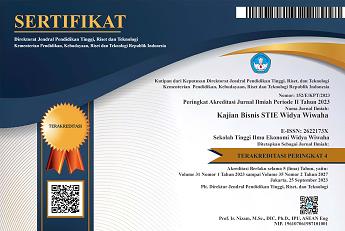PENGARUH JEJARING BISNIS PEMIMPIN DAN JEJARING PEMIMPIN DENGAN PEMERINTAH, KEMAMPUAN MENYERAP PENGETAHUAN, DAN KEUNGGULAN KOMPETITIF UKMKM
DOI:
https://doi.org/10.32477/jkb.v33i1.1061Keywords:
Leader's Businnes Network, Leader's Network with Government, Knowledge Absorption Ability, MSME Competitive AdvantageAbstract
This study aims to examine the influence of leaders' business networks and leaders' networks with the government in creating competitive advantage of Micro, Small and Medium Enterprises (MSMEs), moderated by Knowledge Absorption Ability. This research pays attention to the leader's individual attributes which are important factors and the leader's social network and its interaction with the leader's ability to absorb knowledge, taking the context in Indonesia, especially in Bantul district, Yogyakarta. This study uses a quantitative approach with a survey method, namely by distributing questionnaires. Respondents in this study were 88 owners of wooden batik or hand-written batik MSMEs in Bantul Regency, Yogyakarta Special Region (DIY). The sampling technique used was convenience sampling due to considerations of data availability and convenience for researchers. Partial Least Square (PLS) with Structural Equation Modeling (SEM) application is the data analysis technique used in this study. The results of this study show that leaders' business networks affect the competitive advantage of MSMEs in Bantul Regency. Meanwhile, leaders' network with the government has no effect on competitive advantage in Bantul. Leaders' ability to absorb knowledge does not significantly affect the relationship between leaders' business networks and MSME excellence. Likewise, the leader's ability to absorb knowledge weakens the relationship between the leader's business network and MSME excellence.
References
Abdillah, W., Jogiyanto Hartono, B.U., 2020. Konsep dan aplikasi: Structural equation modeling berbasis varian dalam penelitian bisnis.
Adiputra, I.P.P., Mandala, K., 2017. Pengaruh Kompetensi Dan Kapabilitas Terhadap Keunggulan Kompetitif Dan Kinerja Perusahaan. E-Jurnal Manajemen Unud 6, 6090–6119.
Andrade, C., 2019. The P Value and Statistical Significance: Misunderstandings, Explanations, Challenges, and Alternatives. Indian J Psychol Med 41, 210–215. https://doi.org/10.4103/IJPSYM.IJPSYM_193_19
Bapuji, H., Loree, D., & Crossan, M. (2011). Relying On External Knowledge for Competitive Advantage [Data set]. In Forbes India.
Barney, J., 1991. Firm resources and sustained competitive advantage. J Manage 17, 99–120.
Chow, I.H.-S., Ng, I., 2004. The characteristics of Chinese personal ties (guanxi): Evidence from Hong Kong. Organization Studies 25, 1075–1093.
Cohen, J., 1992. A power primer. Psychol Bull 112, 155–159. https://doi.org/10.1037/0033-2909.112.1.155
Dierickx, I., Cool, K., 1989. Asset stock accumulation and sustainability of competitive advantage. Manage Sci 35, 1504–1511.
Dong, M.C., Li, C.B. and Tse, D.K. (2013), “Do business and political ties differ in cultivating marketing channels for foreign and local firms in China?”, Journal of International Marketing, Vol. 21 No. 1, pp. 39-56.
Dyer, J.H., Singh, H., 1998. The relational view: Cooperative strategy and sources of interorganizational competitive advantage. Academy of management review 23, 660–679.
Faccio, M., Masulis, R., John, J.M., 2006. Political Connections and Corporate Bailouts. Journal of Finance 61, 2597–2635.
Ghozali, I., 2016. Aplikasi analisis multivariete dengan program IBM SPSS 23.
Hartono, J.M., Abdillah, W., 2014. Konsep Aplikasi PLS (Partial Least Square) untuk penelitian empiris, Edisi Pertama. Cetakan Kedua, BPFE, Yogyakarta.
Li, J.J., Poppo, L.Z.K.Z., 2010. Relational Mechanisms, Formal contracts, and Local Knowledge Acquisition by International Subsidiaries. Strategic Management Journal 31, 349–370.
Ngoc Thang, N., Anh Tuan, P., 2020. Knowledge acquisition, knowledge management strategy and innovation: An empirical study of Vietnamese firms. Cogent Business & Management 7, 1786314.
Ong, J. W., Ismail, H., & Yeap, P. F. (2018). Competitive advantage and firm performance: the moderating effect of industry forces. International Journal of Business Performance Management, 19(4), 385. doi:10.1504/ijbpm.2018.095069
Pakaya, A.R., 2011. Pengaruh Manajemen Sumberdaya Manusia Strategi Dan Manajemen Transformasi Terhadap Keunggulan Bersaing. Jurnal Inovasi 8.
Powell, W.W., Koput, K.W., Smith-Doerr, L., 1996. Interorganizational collaboration and the locus of innovation: Networks of learning in biotechnology. Adm Sci Q 116–145.
Sami, P., Rahnavard, F., & Alavi Tabar, A. (2019). The effect of political and business ties on firm performance. Management Research Review. doi:10.1108/mrr-12-2017-0439
Sarstedt, M., Ringle, C.M., Hair, J.F., 2021. Partial Least Squares Structural Equation Modeling, in: Handbook of Market Research. Springer International Publishing, Cham, pp. 1–47. https://doi.org/10.1007/978-3-319-05542-8_15-2
Sheng, S., Zhou, K., Li, J., 2011. The Effects of Business and Political Ties on Firm Performance: Evidence from China. J Mark 75, 1–15. https://doi.org/10.2307/25764291
Uzzi, B. 1996. The sources and consequences of embeddedness for the economic performance of organizations: The network effect. American Sociological Review, 61(4): 674–698.
Wernerfelt, B., 1984. A resource‐based view of the firm. Strategic Management Journal 5, 171–180. https://doi.org/10.1002/smj.4250050207
Wong, K.K.-K., 2013. Partial least squares structural equation modeling (PLS-SEM) techniques using SmartPLS. Marketing bulletin 24, 1–32.
Wu, J., 2011. Asymetric Roles of Business Ties and Political Ties in Product Innovation. J Bus Res 64, 1151–1156. https://doi.org/10.1016/j.jbusres.2011.06.014
Wu, J., Chen, X., 2012. Leaders’ social ties, knowledge acquisition capability and firm competitive advantage. Asia Pacific Journal of Management 29, 331–350. https://doi.org/10.1007/s10490-011-9278-0
Yang, X., Jin, R., Zhao, C., 2022. Platform leadership and sustainable competitive advantage: the mediating role of ambidextrous learning. Front Psychol 13, 836241.
Zheng, W., Singh, K. and Mitchell, W. (2014), “Buffering and enabling: the impact of interlocking political ties on firm survival and sales growth”, Strategic Management Journal, Vol. 36 No. 11, pp. 1615-1636.
Zhou, K.Z., Wu, F., 2010. Technological Capability, Strategic Flexibility, and Product Innovation. Strategic Management Journal 31, 547–561.
Downloads
Published
How to Cite
Issue
Section
License
Copyright (c) 2025 Firma Sulistiyowati, L. Bambang Harnoto, Vincentius Hans Kristian, Vincentius Seto Wicaksono

This work is licensed under a Creative Commons Attribution 4.0 International License.









